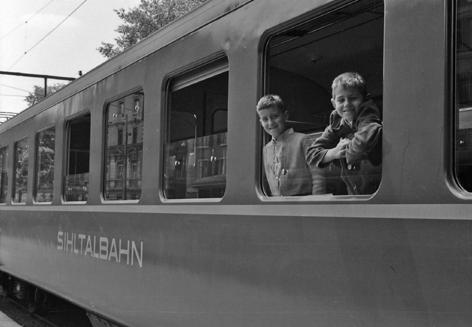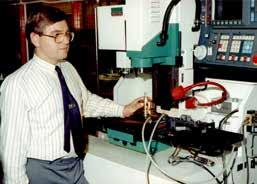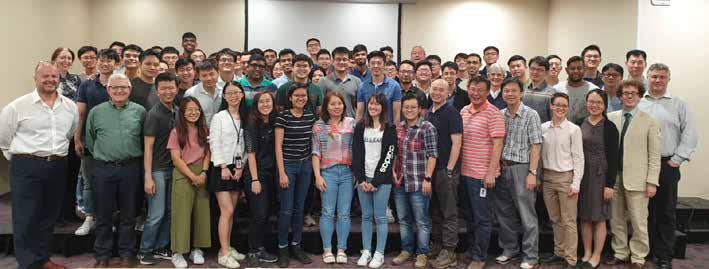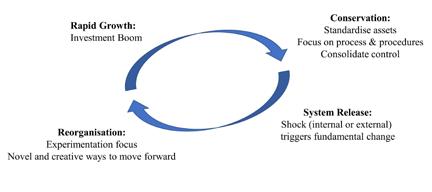
15 minute read
The long history and exciting future of railway systems thinking
MALCOM DOBELL
The Long History and Exciting Future of

RAILWAY SYSTEMS THINKING
Each year, the Institution of Mechanical Engineers’ Railway Division elects an eminent engineer to be its chairman. For 2020-2021, it is Professor emeritus Felix Schmid, recently retired programme director for the MSc in railway systems engineering and integration at the University of Birmingham.
The chairman usually addresses members at the Institution’s headquarters in Westminster and at centres around the country, but this year, due to the COVID-19 pandemic, Felix’s address is virtual. One might assume that he would deliver one address accessible from anywhere, but one would be wrong! Felix is determined to deliver his address to every Railway Division centre, with some unique content for each one, to support centre identities.
This report is based on the South East centre address given in September 2020. Felix packed a lot of interesting and educational information into his talk. At best, this report is selective and anyone interested in hearing the full address might still be able to catch one of the later dates, the last being for Ireland in early 2021. He will also present separately for an audience in India, Japan and Australia.
In time honoured tradition, Felix summarised his career from his childhood to the present day. He was brought up with his brother, Thomas, in Zurich, Switzerland, where their father encouraged them to enjoy railways. He completed a language-oriented baccalaureate with classics – Greek and Latin – before gaining a Master of Engineering equivalent degree from the Swiss Federal Institute of Technology.

After a short spell in software analysis, he moved to England to work with GEC Traction. There, he learnt what he called “practical electricity” and had his first exposure to a management role, where he learnt valuable lessons in building mutual respect with the workforce.
Later he became a research assistant at UMIST in Manchester and then at the University of Salford, before, in 1985, moving south to Brunel University, where he became a lecturer in computer-integrated manufacturing. Felix observed that neither he nor his boss were quite

Felix and Thomas Schmid in 1963.
(Below) GEC Traction, Newton-le-Willows, 1983. Felix is third from the right. (Inset) Brunel University, 1990.


Students and academics in Singapore.
2016 technical tour to Bochum, Germany.
sure what computer-integrated manufacturing was, but that he taught it anyway, gaining a PhD in engineering education whilst at Brunel.
Following a tip-off from his brother, Felix became a railway inspector in Switzerland in 1993. This taught him that he did not have the temperament to be a civil servant, and, in 1994, by serendipity, he was appointed as a senior lecturer at the University of Sheffield to set up a British Railways-sponsored MSc programme in railway systems engineering.
In 2005, the MSc programme, complete with Felix and his team, transferred to the University of Birmingham, where he later became first an associate and then a full professor of railway systems engineering and integration. Gradually, additional MSc programmes were created, including an international programme in Singapore, with Felix as the director of education.
One of the features of his MSc programmes has been the international tours, intended to show participants good practice in solving railway problems. He has also organised four successful technical tours for the IMechE Railway Division. There are literally thousands of railway systems engineers who have been educated by Felix and his team.
What is a system and how does the railway fit in?
Felix then moved on to talk about systems, warning his audience: “This is going to be educational!”
He defined a system as “a group of interacting or interrelated entities that form a unified whole to deliver a defined purpose. A system is described by its spatial and temporal boundaries; it is surrounded and influenced by its environment, described by its structure and purpose and expressed in its functioning. A system can also be a set of principles or procedures by which something is done - an organised scheme or a method.”
He added: “A railway is a system and it has the purpose of transporting people and goods.”
A history lesson of the railway as a system combining track and train, wheel and rail
Felix described some of the very earliest applications of guided wheeled transport, describing how low friction tracks with a guide slot were provided for ore trucks in German iron and silver mines in the 1600s – a sort of early push along Scalextric. They were ideal for the very narrow passageways that were a feature of those mines and the technique was brought to the English Lake District by German miners.
The early railways proper of the 1700s featured rustic tracks with longitudinal timber beams held apart by, and wedged onto, ‘ties’ – recognisable today as sleepers. Iron strips were fixed to the longitudinal timbers. These were known as ’railed ways’, railroads, tramroads or tramways. They exhibited the key feature of all modern track construction, distributing the point loads of wheels on rails through the various components of the track.
4’ 10”
Iron Strap
Tie Wedge Rail
Mud Sill Trench

As Felix said: “You’re talking about point loads of kilonewtons per square millimetre at the rail, and once you reach the natural ground, the load is in the very few newtons or fractions of newtons per mm2. That was, of course, a fantastic achievement. It’s what I call one of the very defining systems aspects of railways and it’s what allowed Stephenson to build a railway across a swamp, Chat Moss.”
The early engineers trying to develop locomotives were very concerned that iron or steel wheels on iron rails would just slip or spin. This led Richard Trevithick to machine serrations on the tread of the wheels on his 1802 steam loco. He demonstrated one of his locomotives on a circle of track in Bloomsbury, London, in 1808, and it is thought that the high loads of the serrated wheels on the track caused rail breaks, leading to derailments and, for Trevithick, bankruptcy. Richard Trevithick’s 1808 demonstration at Bloomsbury.
Trevithick was, however, more successful with the steam propulsion system, commenting: “The fire burns much better when the exhaust steam is blasted up the chimney” – the technique that made steam traction work efficiently at higher power.


Another engineer, John Blenkinsop, developed an early rack and pinion system in 1811, the principles of which much later became very popular on mountain railways, but which was unnecessary on more reasonable gradients and

Distribution of pressure throughout a railway track system.
William Brunton’s ‘Steam Horse’ used mechanical legs to power his locomotive up steep gradients.
imposed slow speed.
John Blenkinsop’s rack and pinion system of 1811.
More extraordinary was William Brunton’s 1813-patented Steam Horse, which used steam powered legs and feet to move the locomotive up hills, managing gradients of up to 1:36. Felix observed that it “was a very, very limited success. The locomotive actually exploded because somebody tied down the safety valve - not such a good idea.”

Stephenson’s Rocket at the Rainhill Trials of 1829.

Rolling forward to 1829 and the Rainhill trials, Felix observed: “Even today, everybody keeps talking about the speed which they achieved – 30mph (48km/h). But the real big achievement was that a locomotive could travel 112km in just one day and was reliable. It was range and reliability that made the fast development of railways possible. Stephenson discovered that his fears about adhesion were not realised. And as we now know, using adhesion and perhaps some sand, gradients of up to 1 in 8 can be managed.”

The Elizabeth line (Crossrail) is a good example of a ‘System of Systems’. What is a system of systems and what are emerging properties?
Following the history lesson, Felix moved to Systems of Systems (SoS), which he defined as “a set of large-scale integrated entities that are different from each other and they can operate independently of each other on their own. But when they are put together and networked, they have different characteristics than as individuals.” He used nature as an example of a system of systems, something worthy of a separate article.
He illustrated the challenges of SoS with the example of Crossrail (the Elizabeth Line) and its many interfaces. As examples of the challenges, Crossrail runs over the territory of three infrastructure managers and interfaces with two others, has three signalling systems and shares tracks with other services at either end of the line. This is a complex system with no one party in overall control.
Felix observed that many people think SoS are 21st century creations, but SoS is merely a new term for describing what has been in existence for a long time, and he compared SoS characteristics with early GB railways. The complicated and complex cature of railways?
Felix said that railway systems are complex, complicated through being closely coupled, all of which he explained in brief.
Complicated systems are those that can be controlled by people with processes and rules, while complex systems are those that are not capable of being controlled easily by people (again with nature as an example).
The complication and complexity of railways were illustrated with a butterfly diagram, outlining the factors involved and how they are related. The 2018 timetable meltdown was an example of complexity. Close coupling contributes to the interdependency of sub-systems. Examples include wheel/ rail, pantograph/overhead conductor, and timetables, fleet and crew rosters.
Felix discussed the significantly complicating aspects of rail, including dispersion of organisations, people and equipment across the network, together with the diversity of components, assets and the skills and knowhow required. He illustrated this with an example of a railway with over 2,200 sets of point machines

Generic SoS Characteristics Managerial, developmental, and operational independence Rapid requirements evolution
Multiple disparate stakeholders, often with conflicting needs and little incentive to work together Emergence resulting from inter- and intrasystem interactions Systems of systems are often geographically dispersed and connected though a network
©: Rhianne Evans and Duncan Kemp
of 29 different types: all controlled through lists, databases, procedures and knowhow. Whilst such diversity of equipment may not be desirable, it is quite normal on large established networks.
What makes railways difficult to manage
When things go wrong in complicated and complex systems, there is often a management preoccupation with finding out what went wrong, and why. Felix suggested that ‘how?’ may be a more useful question than ‘why?’, as it elicits more information and that it is also productive to find out what works well and how organisations can ‘do the right things’ more often.
Based on the old railway adage ‘the railways would run a lot better if it weren’t for the passengers’, Felix observed that performance (delivery and punctuality) of the troublesome Deansgate corridor through Manchester has dramatically improved during the COVID-19 lockdown, when passenger numbers reduced by 90% or so. This experience provides lessons for operators – perhaps fewer longer trains might deliver better performance as passengers return?
Perrow’s ‘Normal Accident’ theory
Felix also highlighted work by Charles Perrow, a sociologist at Yale and Stanford Universities, arguing that accidents in complex systems – as described here – are not completely avoidable, regardless of preventive effort. Perrow also suggested that technical solutions are not adequate mitigation because most incidents have organisational roots. Such systems have to respond to events and must adapt as the environment and other agents in the system change.
Part of this is caused by the fact that success and failure often have the same genesis. Felix discussed situations where normal work features degrees of non-compliance and workarounds, often because the real world diverges from the paper world. Most of the time, non-compliance and workarounds lead to success but, occasionally, they lead to failure. No one worries about the thousands of times where there was success, Characteristics of early GB Railways 150 railways with separate owners and operators Rapid growth of network, services, passengers and performance Passengers, cities, shareholders, govenmnet, suppliers all have different needs and aspirations Emergence of cross network travel opportunities required new rules Trains spread across the whole country though he physical (rail) network Characteristics of Systems of Systems compared with early railways in GB.
but organisations always seek to prevent the rare failure. Unfortunately, the failure prevention actions may reduce the frequency of success.
Felix gave an example of a helicopter picking up injured people where the helicopter lands with its rotor skimming the top of the snow. People get rescued safely and nobody talks about it anymore. If the same helicopter’s rotor had dug into the snow leading to an accident, there would have been a big investigation with the conclusion that the root cause was a reckless pilot despite having relied upon the same apparent recklessness to successfully rescue many injured mountaineers or skiers.
The system lifecycle Vee model for the railway
With all the challenges of complication and complexity, Felix suggested that there were no certain solutions available but there were techniques which organisations might employ to minimise the inevitable challenges. He explained the CENELEC system Vee life cycle which he teaches to all his students, but he had added three opportunities.
Firstly, during the Concept, System Definition and Application Conditions, and System Requirements stages, there is the opportunity to address complexity.
Secondly, during System Requirements, Apportionment of System Requirements, and Design and Implementation stages there is the opportunity to address complication.

CENELEC system lifecycle Vee model.
Complex Systems Adaptive Cycle.

And thirdly, during System Acceptance and Operation and Maintenance stages there is a further opportunity to address complexity.
He also added that anything planned at the concept stage for Operations and Maintenance and Decommissioning Disposal is unlikely to be what actually happens. For example, no one who designed the old New York ‘Redbird’ subway cars would ever have imagined that they would be sunk in the ocean to become reefs for sea life.
In any large railway, there are probably hundreds if not thousands of system Vee cycles in operation at any one time and, irrespective of how well they are applied, they do not prevent unintended consequences or undesired emergent properties.
Felix described other approaches which had been presented by an Australian colleague, Alexandra McGrath. This is the Complex Systems Adaptive Cycle, originated by Brian Walker and David Salt in 2006. This is illustrated by four phases with rail examples in brackets: Rapid Growth - often accompanied by an investment boom (pioneering railways), Conservation - where assets procedures and control are standardised or consolidated (railway grouping 1923, British Railways 1948), Shock - internal or external events trigger fundamental change (arguably the spate of rail crashes in the late 1990s/early 2000s), and Reorganisation - experimentation focus with novel and creative ways to move forward (perhaps this is the way forward from Covid-19).
Reducing complication works well during Rapid Growth, ideally leading to standard and repeatable solutions. However, Conservation can result in excessive control and in entrenchment and non-compliance. Following a shock (Release phase), swift intervention is necessary to put in place the building blocks for the next cycle, which usually leads to Reorganisation and some fundamental engineering research and innovation. Felix added that resilience, or lack thereof, is often demonstrated at the System Release phase, but the best place to put resilience in place is when systems are being designed.
Felix illustrated the Adaptive Cycle through the Hatfield derailment on 17 October 2000, where an inter-city train derailed whilst travelling at 120mph. Sadly, four people died and 70 were injured. Well-ordered processes had been disrupted, probably unknowingly, during privatisation.
Previously, one organisation was responsible for track maintenance and planning, but there were now at least four (the train operator with a say in access arrangements, Railtrack with overall responsibility for the track, the track maintenance contractor and the track renewals contractor) with multiple hierarchies, different technical disciplines and with sometimes conflicting incentives. In this close coupled system, it was not possible to gain access to inspect the rail, communications channels were long and therefore rolling contact fatigue was not recognised until it was very severe. It was too hard to arrange rapid replacement and no one put mitigation measures in place.
Following the accident, widespread rolling contact fatigue was found and emergency speed restrictions were imposed across the whole network; a network wide crisis. Resulting from this derailment, Railtrack became Network Rail, track maintenance was brought in-house and a great deal of research led to fundamental changes in how the rail industry managed rolling contact fatigue.
Concluding remarks
Felix concluded his talk with some blatant advertising for the IMechE Railway Division’s Annual Luncheon which will be held virtually for the first time on 5 March 2021. He encouraged organisations to set up lunch in a room for their teams and guests with an online video link so they can connect with friends and colleagues whilst listening to the Railway Division update and a stimulating guest speaker. Whilst intended as a one-off, it could be the biggest Railway Division event yet.
And finally...
This report has omitted many interesting points made by Felix. If you want to hear about the Turkish, the Chinese and the porridge, the purple signal aspect, the Railway Children charity or Paddy, it might not be too late to tune into one of his later addresses – one firm date is on 11 November hosted by the Railway Division Midlands Centre; booking though the IMechE website, events section.
Thanks to Professor Felix Schmid for his support and assistance in preparing this report and to his colleague Alexandra McGrath for permission to publish some of her illustrations.










